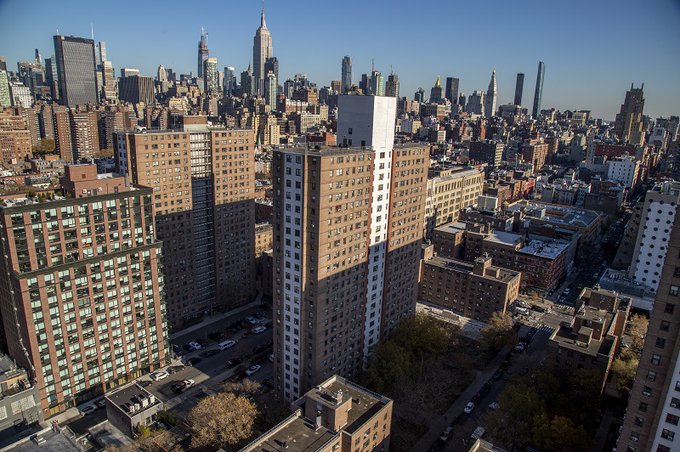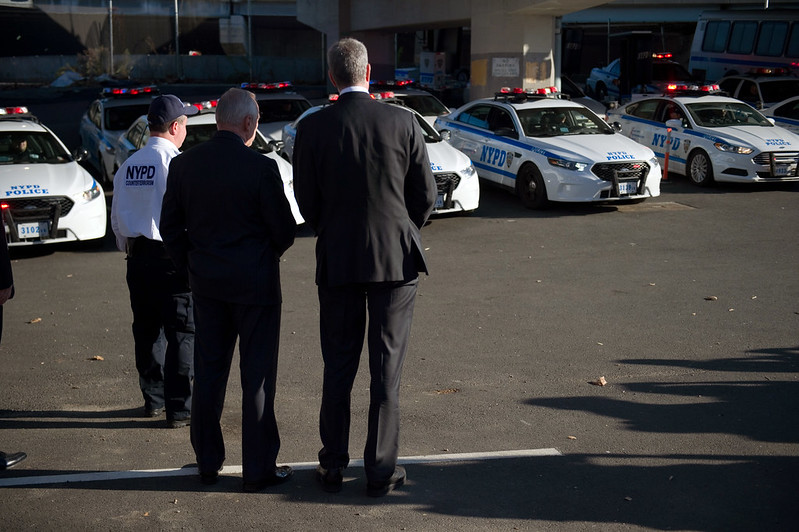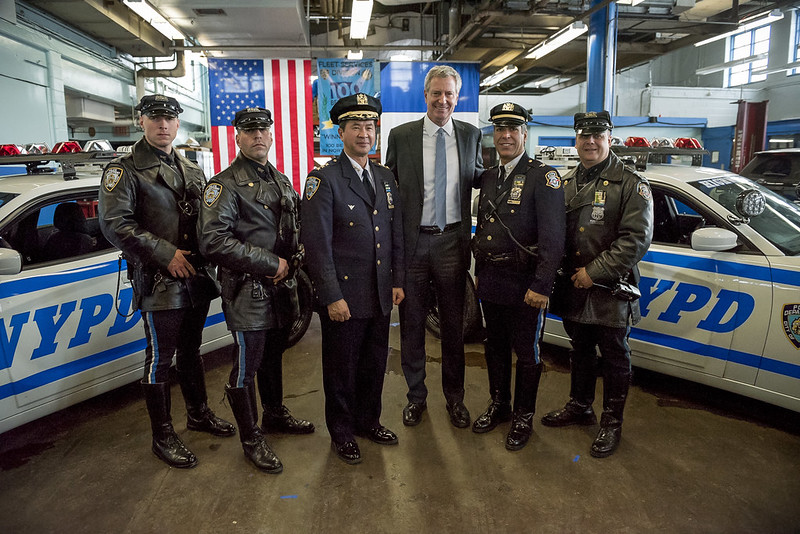At NYCHA, Home is No Safe Harbor - But It Must Be

NYCHA in Manhattan (photo: NYCHA)
The coronavirus pandemic has shone a stark and unflattering light on the inadequacy of the social safety net in our city and across this country. And nowhere is this failure more glaring than at the New York City Housing Authority, or NYCHA.
Due to COVID-19, we all must “shelter in place” in the safety of our homes, but for over half a million NYCHA residents, home is no safe harbor. Years of state and federal underfunding have left buildings with no hot water, toxic mold, lead paint, unhygienic conditions, and countless outstanding repairs.
NYCHA, which is essentially run by the Mayor under the watch of a federal monitor, has a crumbling infrastructure and legacy of mismanagement that virtually guaranteed a slow and ineffective response to the pandemic. Yet the Authority made promises it knew it could never deliver on, claiming in March that it would start disinfecting all buildings at least three times per week — five times for senior buildings. But tenants confirm that this is not happening and their buildings continue to be hotbeds for the spread of the virus. One tenant advocate clearly stated the grave stakes of NYCHA’s failure: “People are going to die in their apartments.”
Let’s be clear: the high levels of infection and fatalities - the full scope of which we may never know - did not have to happen. The severity of this pandemic’s impact on NYCHA residents could have been prevented if New York did not persistently underfund and neglect NYCHA’s infrastructure. For years, community advocates and many of us in the state Legislature have been urgently pleading for the state and federal governments to take action on cleaning, funding, and fixing NYCHA. Our pleas have been ignored again and again.
This chronic disinvestment in NYCHA was completely unacceptable long before this crisis began. It was unacceptable when NYCHA residents were left without heat or hot water due to failing boilers during the coldest winter months. It was unacceptable when botched lead-based paint inspections left tenants exposed to deadly toxins. And it is unacceptable now. It is clearer than ever that the government’s failure to support NYCHA has always cost lives, and now it’s costing lives more than ever.
For NYCHA residents, this is a story of compounding inequalities. Many of the folks who live in one of NYCHA’s roughly 174,000 apartments are also the essential workers at the frontlines of the COVID-19 pandemic. They are taking care of us in our hospitals, making sure we can still get our weekly groceries, keeping our water and electricity running, and operating our buses and subway system — all while putting themselves at further risk of infection. It is beyond shameful that when they get home from high-risk work, they are still in danger, perhaps more so, because of unclean and unsafe apartments. And for NYCHA’s senior population, the risk of infection and death is even higher.
This is outrageous, bordering on criminal, and demands further action at every level of government; city, state and federal. Decades of underfunding by the federal and state governments are only part of the problem. NYCHA’s history of dishonesty, corruption, and managerial incompetence have made it far worse. And just days ago, NYCHA’s federal monitor admitted that they will be unable to meet their goals for identifying and repairing unsafe conditions on time.
More than anything, I am deeply saddened by the way our NYCHA residents are being willfully ignored and mistreated — they deserve a government that will fight for them, not turn a blind eye to their suffering. Like so many institutions of government, NYCHA needs to rebuild trust with its residents, and that starts with honestly and competently addressing the problems they are facing today, not making false promises or missing more deadlines.
We need NYCHA’s leadership to come forward with real, workable plans, with real timelines, not only to address the pandemic as it recedes and potentially rises again into a new wave of sickness and death, but also on the many long-standing repairs and other health and safety issues that continue to threaten NYCHA residents. And we need all levels of government at the table to finally fund our public housing so it can provide safe shelter to public housing tenants. We needed to do this yesterday.
***
State Assemblymember Yuh-Line Niou represents parts of Lower Manhattan. On Twitter @yuhline.
***
Have an op-ed idea or submission for Gotham Gazette? Email This email address is being protected from spambots. You need JavaScript enabled to view it.
The Necessity of New York City Budget Justice

Mayor de Blasio at an NYPD lot (photo: Ed Reed/Mayoral Photography Office)
Like other major cities reeling from the COVID-19 pandemic, New York is facing a serious budget deficit and we have to make difficult choices about where to cut funding and where to redirect resources. This crisis has exposed the agonizing holes in our city’s social safety net like a raw nerve. We’ve been bombarded with news of the massive inequities faced by essential workers and low-income New Yorkers most at risk from the virus, the horrifying racial disparities in COVID-19 deaths, and our anemic personal protective equipment (PPE) stockpiles for frontline workers.
In recent weeks, we saw black New Yorkers’ rage over these inequities combust with cumulative trauma about the racist, violent over-policing we have endured for decades. Our over-investment in policing is directly related to our under-investment in our most vulnerable communities. The question is not whether we have to make difficult choices, it’s "are we going to make the same bad choices that got us into this situation, again?"
Elected officials have long used NYPD initiatives as a cosmetic fix to gloss over much deeper problems, not acknowledging that racist and abusive policing is one of those deeper problems. Instead of housing the homelessness or triaging and mending our broken mental health treatment system, our leaders used Rikers Island and other city jails as a depository for mentally ill or homeless New Yorkers. Instead of dealing with the profound damage done to communities by segregation, displacement, hyper-gentrification, and widening inequality, they stopped-and-frisked an entire generation of black and Latino New Yorkers into submission.
Mayor de Blasio avoided grappling with these gaps in the city’s social service infrastructure, instead taking the easier route of placating right-wing police unions and letting our police force grow and operate virtually unchecked. And then the coronavirus hit, and the gaps in our underfunded social services widened into an abyss.
We scrambled to house people who should have been housed already. We watched COVID-19 spread through our jails, killing people who should have been freed already. We watched it decimate nursing homes, which were undermined by bad policies and left unprepared for the looming disaster. We mourned the preventable deaths of thousands of low-income, mostly black and Latino New Yorkers with inadequate access to healthcare, housing, and other resources. And all of the billions we have invested in the NYPD — their bulletproof SUVs, bulked-up “Hercules teams,” underwater drones, and bizarre surveillance gear — haven’t saved a single life because you can't arrest your way out of a pandemic.
This crisis and this next city budget due by July 1 present the obligation and the opportunity to put our moral house in order. While more than 10 extraordinary days of protest have forced Mayor de Blasio to publicly accept cuts to the NYPD, he has named no dollar amount, suggesting a hollow commitment to meaningful change, and a continued unwillingness to face either the rot in his own police department, or the exigencies of New York’s COVID crisis.
If de Blasio won’t act decisively, City Council Speaker Corey Johnson should instead listen to the voices of millions of New Yorkers, thousands of community advocates, and a ballooning list of his own Council members, and commit to reducing the NYPD’s budget by $1 billion this year. The Council should invest those funds in the communities that have been devastated by the pandemic, and so poorly served by this city for years, by restoring the programs Mayor de Blasio proposed to cut.
Why $1 billion? For a start, the NYPD should impose the same hiring freeze other city agencies are facing. The daily videos of police swarms descending on protesters proved we don’t need more cops. An NYPD hiring freeze puts over $200 million back into our communities.
The city paid out a disgraceful $230 million to settle lawsuits against the NYPD in 2019. Since claims against the NYPD come out of another pot of money, the department has little financial incentive to reduce misconduct. Moving money from one ledger to another cannot truly address the harm and trauma caused by police officers’ transgressions, but we can at least force the NYPD to pay for misconduct out of its own pocket.
Next the NYPD’s inappropriate incursion into social services must be reversed. Instead of paying the NYPD to engage in coercive homeless “outreach” and mental health responses, the city should use that money to fund social workers and agencies with the skills and resources to care for those populations. The presence of cops instead of counselors creates the same racist outcomes that always follow the arrival of the NYPD, with black and Latino children disproportionately dumped into the school-to-prison pipeline. One of the heftiest NYPD social services price tags is the $332 million that pays for the NYPD to be in Department of Education schools.
The City Council should scour the NYPD’s hyper-militarized budget for extravagances such as the department’s brand-new fleet of 14 drones, its six bomb-seeking underwater robots (have they ever actually found a bomb?), and its bizarre X-ray vans, With bad policy and bloated excess, it doesn’t take long to find $1 billion for the coming 2021 Fiscal Year that the people of New York need to survive this crisis, and the NYPD can live without.
The COVID-19 crisis and our current budget crunch forces us to ask the questions we should have been asking all along: Are police and their gadgets truly more essential than the lives and safety of doctors and nurses? More essential than the thousands of low-wage workers — many undocumented — that are keeping food and critical goods flowing throughout our city at great risk to themselves and their families? Is “order” more essential than justice? And of course the question we have been asking all along: do black lives matter? Will the city we call home finally learn to cherish us, or leave us to the mercy of cops, COVID, and the next cycle of racist neglect?
***
Leo Ferguson is on staff at Jews For Racial & Economic Justice, a leader in the Black Jewish racial justice movement, and works with Communities United for Police Reform. Anthonine Pierre is the Deputy Director of the Brooklyn Movement Center, a Black-led community organizing group in Central Brooklyn and a member of Communities United for Police Reform. On Twitter @LeoFergusonnyc & @JFREJNYC; @AnthoninePierre & @bkmovement.
***
Have an op-ed idea or submission for Gotham Gazette? Email This email address is being protected from spambots. You need JavaScript enabled to view it.
Remove the NYPD from the Enforcement of Streets and Sidewalks

Mayor de Blasio with NYPD transportation (photo: Ed Reed/Mayoral Photography Office)
Streets and sidewalks make up a majority of New York City’s public space. Like the parks and open spaces that make up the rest of it, these spaces should serve a common good, accessible for all to travel, to play, and to protest without harm. But there is ample evidence that this is not a reality.
Consider what happened when Mayor de Blasio cracked down on social distancing last month. Nine out of ten arrested for walking, standing, or sitting too close in public space were black and Latino; so were 82 percent of those summonsed. The crackdown was an echo of stop-and-frisk, a decades-long policy of police harassing people on city sidewalks. From 2002 to 2013, black and Latino people were nine times more likely to be stopped by police even though white people were twice as likely to be found with a gun.
Or consider how the streets are policed. For example, in New York City, more than 89 percent of tickets issued last year for crossing the street midblock or against the light went to blacks and Latinos. Nationwide, black drivers are almost twice as likely to be pulled over as white drivers, and four times as likely to be searched, despite being less likely to be found with drugs, guns, or alcohol.
These statistics are echoed in stories of where harassment in public space often leads: Sean Bell, a 23-year-old black man, unarmed and killed by police who shot 50 rounds into his car on a Queens street in 2006; Eric Garner, a 44-year black man, unarmed and strangled to death by police on a Staten Island sidewalk in 2014; Maurice Gordon, a 28-year-old black man, unarmed and killed by police in a traffic stop on a New Jersey highway just a few weeks ago.
These killings all occurred on streets and sidewalks. Making these spaces work for the common good of all begins with ending police enforcement of streets and sidewalks.
This shift in the dominant paradigm is more than possible. Consider one small example, found in the “Open Streets” program launched in New York City two months ago.
When Mayor de Blasio first launched this pilot program, the bike and pedestrian thoroughfares were maintained by the NYPD and heavily policed. Advocates predicted the police would intimidate New Yorkers, especially in neighborhoods of color, and diminish attendance. Mayor de Blasio insisted police presence was necessary. Advocates proved right, and Mayor de Blasio canceled the program, claiming police resources were stretched too thin for such low attendance.
Weeks later, under pressure from the City Council and thousands of New Yorkers, Mayor de Blasio restarted the Open Streets program without police. In this police-free iteration, the program was wildly popular. Still, the program largely excludes neighborhoods of color, evidence of how fixing systemic racism will be more complicated than ending police enforcement.
These two versions of an Open Streets program show how antiquated and wrongheaded ideas about the necessity of police enforcement are. As advocates for communities of color and safe, equitable transportation alternatives, we believe that it is time to end NYPD enforcement of streets and sidewalks. This could do more than make public spaces fair, it could save lives.
What if the money that once went to traffic enforcement, for example, funded traffic engineering instead? Policing streets is not only a physical threat to New Yorkers of color but an ineffective way to control unsafe driving behavior. More effective is when streets, by design, “police” themselves, as the New York City Department of Transportation (DOT) has proven many times over in redesigning public spaces to reduce speeding, cycling on the sidewalk, even the behaviors that cause crashes. Unlike intermittent, selective, and biased traffic enforcement, these changes are permanent and systemic, affecting all who use the streets or sidewalk equally.
The NYPD budget is more than five times that of the DOT. That money could be redistributed to repair the harm caused by racist policing -- funding schools, social services, and redesigned streets. It is time to stop spending so much on practices that harm people of color and use that money to fund permanent systemic improvements for the common good.
***
Mark Winston Griffith is executive director at Brooklyn Movement Center. Danny Harris is executive director at Transportation Alternatives. On Twitter @GriffithMW & @BKMovement; @DannyHarris_TA & @TransAlt.
***
Have an op-ed idea or submission for Gotham Gazette? Email This email address is being protected from spambots. You need JavaScript enabled to view it.




